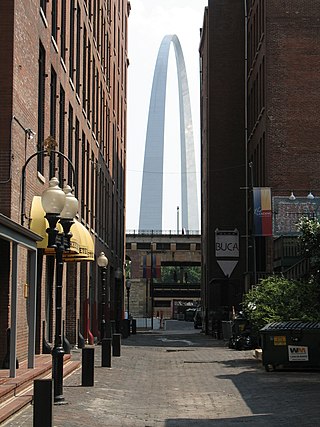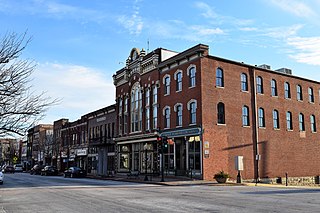
Osage County is a county in the central part of the U.S. state of Missouri. As of the 2020 census, the population was 13,274. Its county seat is Linn. The county was organized January 29, 1841, and named from the Osage River.

Florissant is a city in St. Louis County, Missouri, within Greater St. Louis. It is a middle-class, second-ring northern suburb of St. Louis. Based on the 2020 United States census, the city had a total population of 52,533.

Mount Vernon is a neighborhood of Baltimore, Maryland, located immediately north of the city's downtown district. Designated a city Cultural District, it is one of the oldest neighborhoods originally home to the city's wealthiest and most fashionable families. The name derives from Mount Vernon, the home of George Washington, given the original Washington Monument, a massive pillar commenced in 1815 to commemorate the first president of the United States, is the defining feature of the neighborhood.

Bonnots Mill is an unincorporated community in northern Osage County, Missouri, United States. It is located approximately ten miles east of Jefferson City on the Osage River, near its confluence with the Missouri River. The community of Osage City is about four miles to the west-southwest on the Osage and the community of Tebbetts lies across the Missouri River valley to the north. It has also been known as Dauphine, Bonnets Mills, Bonnots, or Bonnotts Mill.

This is a list of properties and historic districts in Missouri on the National Register of Historic Places. There are NRHP listings in all of Missouri's 114 counties and the one independent city of St. Louis.

St. Cecilia Church is a Roman Catholic parish church in the Roman Catholic Archdiocese of New York and a historic landmark located at 120 East 106th Street between Park Avenue and Lexington Avenue, Manhattan, New York City, New York. The parish was established in 1873. It was staffed by the Redemptorist Fathers from 1939 to 2007. The church was designated a New York City landmark in 1976. The church and convent were listed on the U.S. National Register of Historic Places in 1984.

The architecture of St. Louis exhibits a variety of commercial, residential, and monumental architecture. St. Louis, Missouri is known for the Gateway Arch, the tallest monument constructed in the United States. Architectural influences reflected in the area include French Colonial, German, early American, European influenced, French Second Empire, Victorian, and modern architectural styles.

The Dauphine Hotel is a historic hotel building located at Bonnots Mill, Osage County, Missouri. It was built about 1840 and expanded in 1879, and is a two-story, frame and brick building with a modified "U"-plan. The main block is six bays long and a two-story gallery spans its entire front.

The Hinton Historic District is a national historic district located at Hinton, Summers County, West Virginia. The original Hinton Historic District is bordered roughly by the Chesapeake and Ohio Railroad line, James Street, 5th Avenue, and Roundhouse. The boundary increase extended the district to include Mill Street. It was listed on the National Register of Historic Places in 1984 and revised in 2005.

Louis Singleton Curtiss was a Canadian-born American architect. Notable as a pioneer of the curtain wall design, he was once described as "the Frank Lloyd Wright of Kansas City". In his career, he designed more than 200 buildings, though not all were realized. There are approximately 30 examples of his work still extant in Kansas City, Missouri where Curtiss spent his career, including his best known design, the Boley Clothing Company Building. Other notable works can be found throughout the American midwest.

Barnett, Haynes & Barnett was a prominent architectural firm based in St. Louis, Missouri. Their credits include many familiar St. Louis landmarks, especially a number related to the local Catholic church. Their best-known building is probably the Cathedral Basilica of St. Louis. A number of the firm's works are listed on the U.S. National Register of Historic Places.

St. Mary's Catholic Church is a parish of the Archdiocese of Dubuque. The church is located in Guttenberg, Iowa, United States. It is listed on the National Register of Historic Places as St. Mary's Catholic Church Historic District. In addition to the church, the historic district includes the parish rectory, convent, and school building.

St. John Nepomuk Parish Historic District is centered on the Catholic parish of St. John Nepomuk in the Soulard neighborhood of St. Louis, Missouri, United States. The historic district is listed on the National Register of Historic Places.

St. Liborius Church and Buildings is centered on the former Catholic parish of St. Liborius in the St. Louis Place neighborhood of St. Louis, Missouri, United States. The historic district is listed on the National Register of Historic Places and it is listed as a City Landmark in St. Louis.

St. Francis Xavier College Church is a Catholic church in the Midtown neighborhood of St. Louis, Missouri, United States. The church was built by the Society of Jesus in 1836: the current building dates from 1884. It serves as a parish church in the Archdiocese of St. Louis and for the Saint Louis University community. It is a contributing property in the Midtown Historic District on the National Register of Historic Places and it is listed as a City Landmark in St. Louis.

Missouri State Capitol Historic District is a national historic district located at Jefferson City, Cole County, Missouri. It encompasses 122 contributing buildings in the central business district of Jefferson City. The district developed between about 1850 and 1950, and includes representative examples of Classical Revival, Late Victorian, Queen Anne, Mission Revival, and Modern Movement style architecture. Located in the district are the separately listed Missouri State Capitol, Lohman's Landing Building, Cole County Historical Society Building, Cole County Courthouse and Jail-Sheriff's House, Missouri Governor's Mansion, and Tergin Apartment Building. Other notable buildings include the St. Peter's Roman Catholic Church complex (1881-1883), Margaret Upshulte House, Broadway State Office Building (1938), Supreme Court of Missouri (1905-1906), U.S. Post Office and Courthouse (1932-1934), Lohman's Opera House, Missouri State Optical, First United Methodist Church (1900), Carnegie Public Library (1901), Temple Beth El (1883), and Joseph and Susie Kolkmeyer House.

The Sainte Marie Roman Catholic Church Parish Historic District, located in the city of Manchester, New Hampshire, United States, includes seven red brick buildings dating from the late 19th century and 20th century. The district was placed on the National Register of Historic Places in September 2019.



















